On-field Violence, Fighting and Injuries in Sports: A Sociology Perspective
VerifiedAdded on 2023/06/08
|8
|1889
|349
AI Summary
This paper explores on-field violence, fighting, and injuries in sports using Joey Burton as the case study. It discusses the reasons why athletes indulge in on-field violence and the effectiveness of sanctions and penalties imposed by football bodies towards players who engage in on-field violence. The proposed solution is to develop a community education program to create an ethical culture that every stakeholder in the club should follow.
Contribute Materials
Your contribution can guide someone’s learning journey. Share your
documents today.
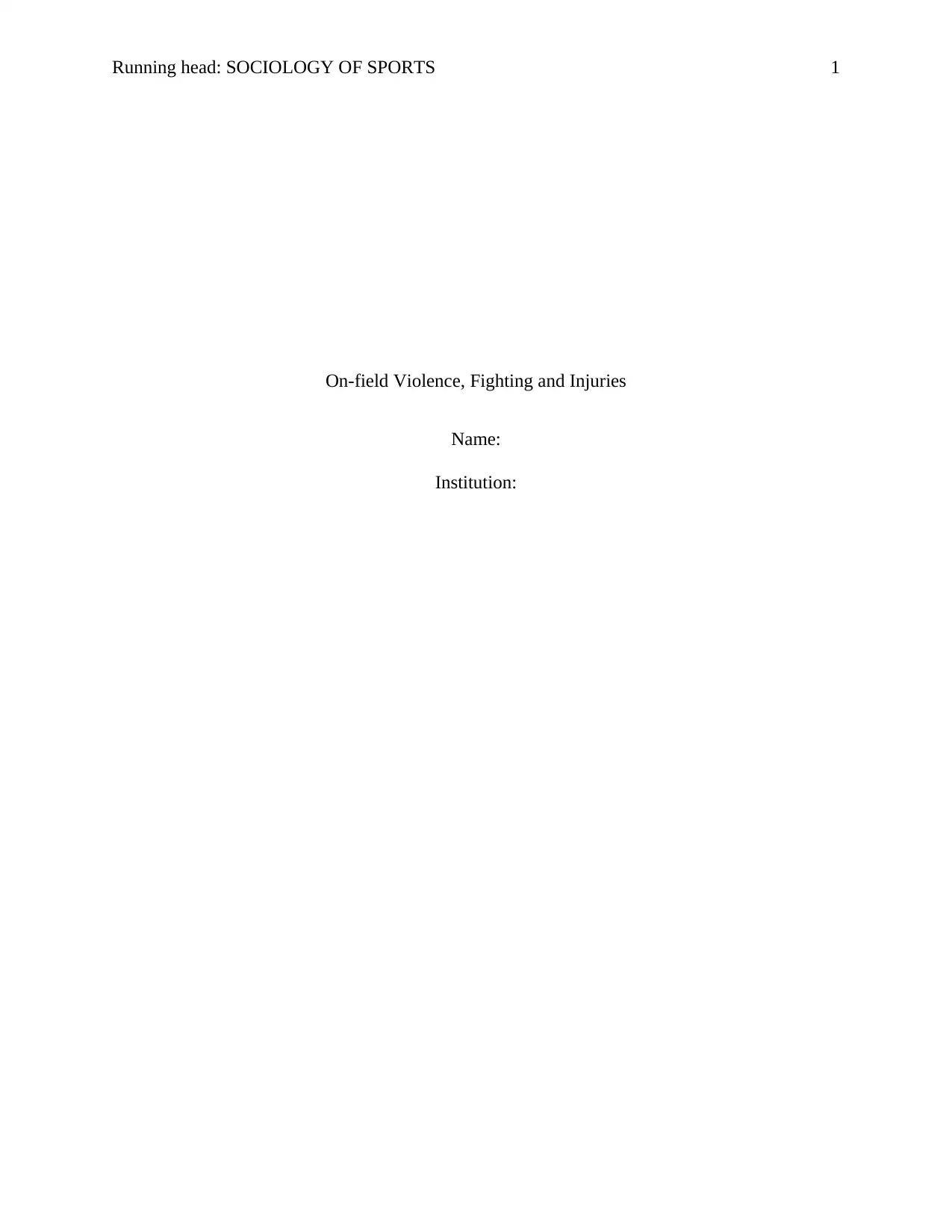
Running head: SOCIOLOGY OF SPORTS 1
On-field Violence, Fighting and Injuries
Name:
Institution:
On-field Violence, Fighting and Injuries
Name:
Institution:
Secure Best Marks with AI Grader
Need help grading? Try our AI Grader for instant feedback on your assignments.
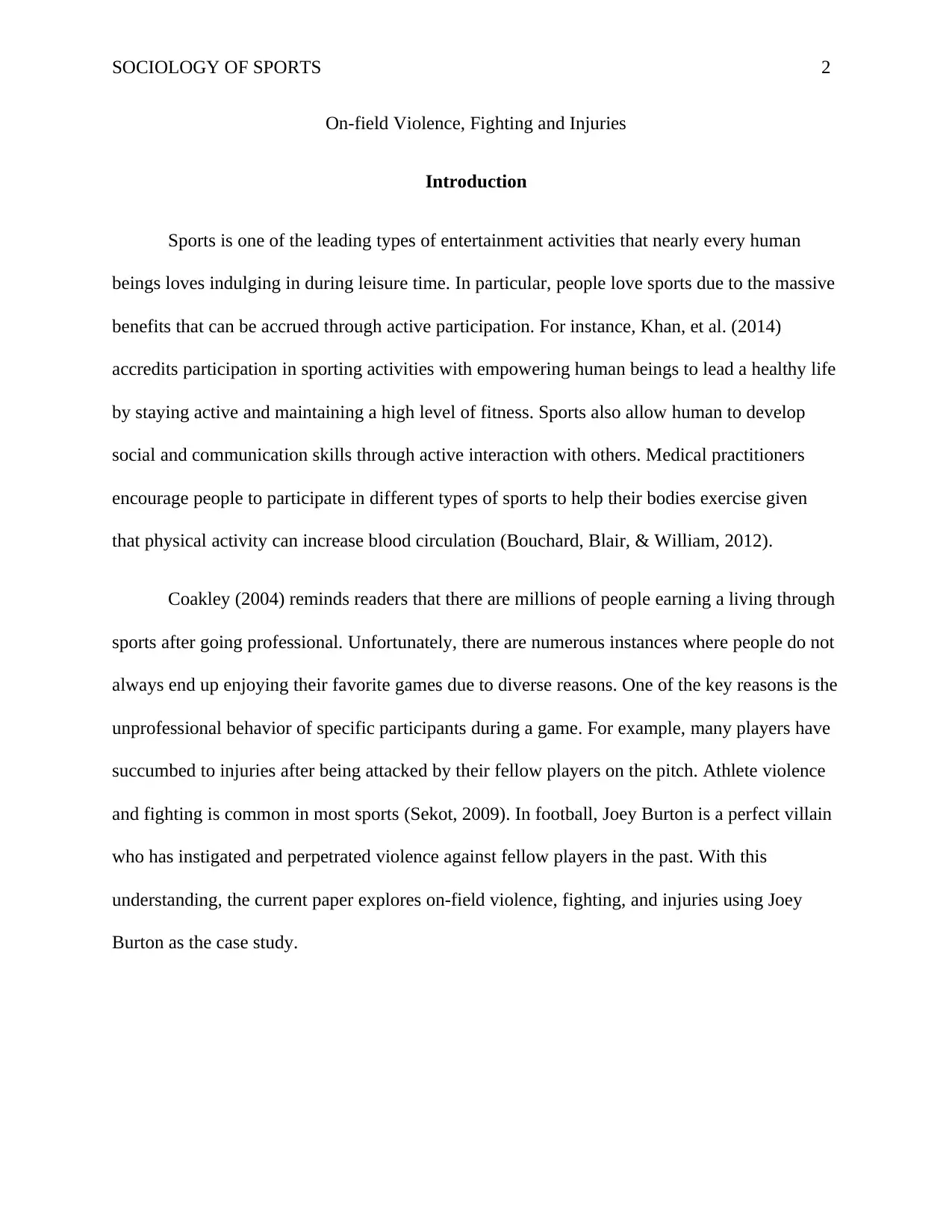
SOCIOLOGY OF SPORTS 2
On-field Violence, Fighting and Injuries
Introduction
Sports is one of the leading types of entertainment activities that nearly every human
beings loves indulging in during leisure time. In particular, people love sports due to the massive
benefits that can be accrued through active participation. For instance, Khan, et al. (2014)
accredits participation in sporting activities with empowering human beings to lead a healthy life
by staying active and maintaining a high level of fitness. Sports also allow human to develop
social and communication skills through active interaction with others. Medical practitioners
encourage people to participate in different types of sports to help their bodies exercise given
that physical activity can increase blood circulation (Bouchard, Blair, & William, 2012).
Coakley (2004) reminds readers that there are millions of people earning a living through
sports after going professional. Unfortunately, there are numerous instances where people do not
always end up enjoying their favorite games due to diverse reasons. One of the key reasons is the
unprofessional behavior of specific participants during a game. For example, many players have
succumbed to injuries after being attacked by their fellow players on the pitch. Athlete violence
and fighting is common in most sports (Sekot, 2009). In football, Joey Burton is a perfect villain
who has instigated and perpetrated violence against fellow players in the past. With this
understanding, the current paper explores on-field violence, fighting, and injuries using Joey
Burton as the case study.
On-field Violence, Fighting and Injuries
Introduction
Sports is one of the leading types of entertainment activities that nearly every human
beings loves indulging in during leisure time. In particular, people love sports due to the massive
benefits that can be accrued through active participation. For instance, Khan, et al. (2014)
accredits participation in sporting activities with empowering human beings to lead a healthy life
by staying active and maintaining a high level of fitness. Sports also allow human to develop
social and communication skills through active interaction with others. Medical practitioners
encourage people to participate in different types of sports to help their bodies exercise given
that physical activity can increase blood circulation (Bouchard, Blair, & William, 2012).
Coakley (2004) reminds readers that there are millions of people earning a living through
sports after going professional. Unfortunately, there are numerous instances where people do not
always end up enjoying their favorite games due to diverse reasons. One of the key reasons is the
unprofessional behavior of specific participants during a game. For example, many players have
succumbed to injuries after being attacked by their fellow players on the pitch. Athlete violence
and fighting is common in most sports (Sekot, 2009). In football, Joey Burton is a perfect villain
who has instigated and perpetrated violence against fellow players in the past. With this
understanding, the current paper explores on-field violence, fighting, and injuries using Joey
Burton as the case study.
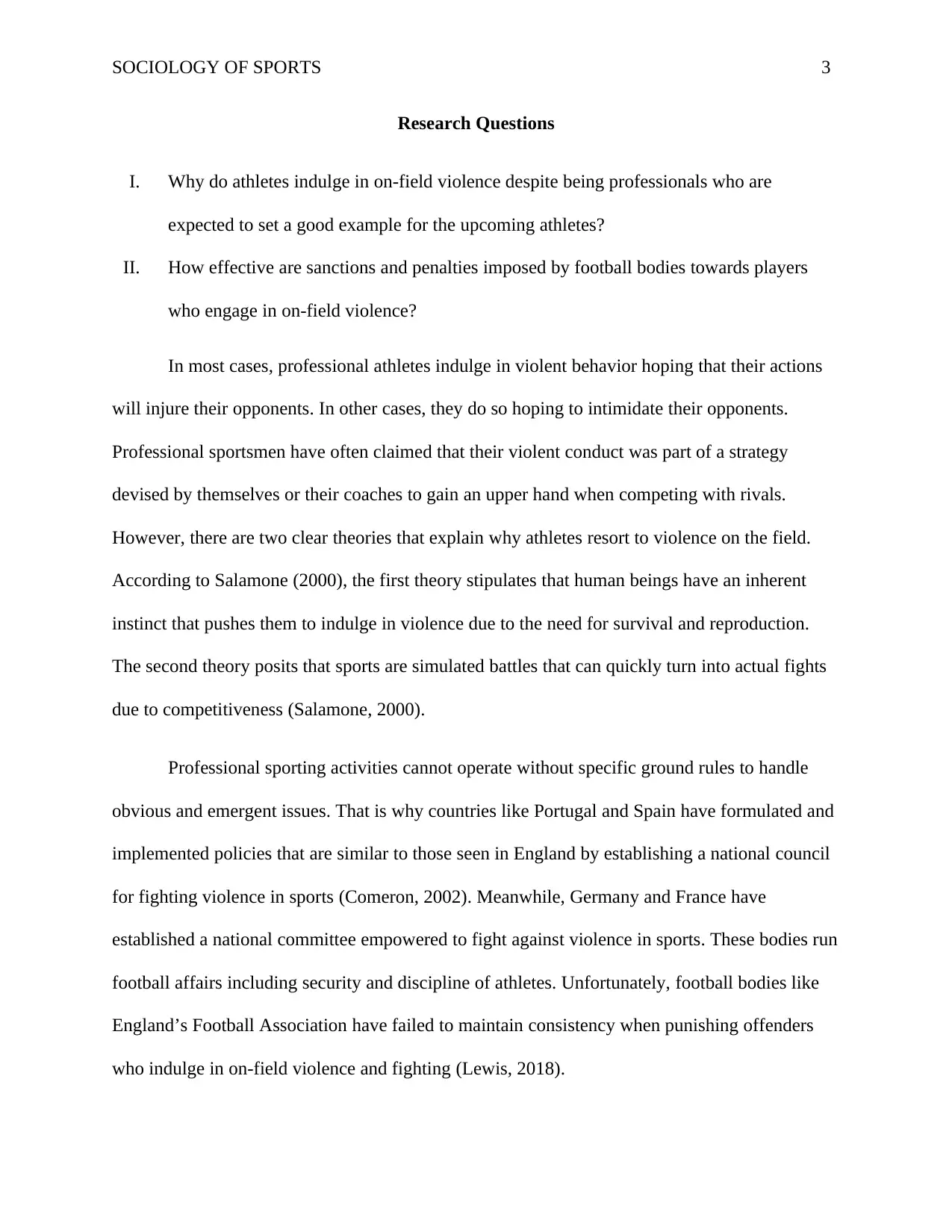
SOCIOLOGY OF SPORTS 3
Research Questions
I. Why do athletes indulge in on-field violence despite being professionals who are
expected to set a good example for the upcoming athletes?
II. How effective are sanctions and penalties imposed by football bodies towards players
who engage in on-field violence?
In most cases, professional athletes indulge in violent behavior hoping that their actions
will injure their opponents. In other cases, they do so hoping to intimidate their opponents.
Professional sportsmen have often claimed that their violent conduct was part of a strategy
devised by themselves or their coaches to gain an upper hand when competing with rivals.
However, there are two clear theories that explain why athletes resort to violence on the field.
According to Salamone (2000), the first theory stipulates that human beings have an inherent
instinct that pushes them to indulge in violence due to the need for survival and reproduction.
The second theory posits that sports are simulated battles that can quickly turn into actual fights
due to competitiveness (Salamone, 2000).
Professional sporting activities cannot operate without specific ground rules to handle
obvious and emergent issues. That is why countries like Portugal and Spain have formulated and
implemented policies that are similar to those seen in England by establishing a national council
for fighting violence in sports (Comeron, 2002). Meanwhile, Germany and France have
established a national committee empowered to fight against violence in sports. These bodies run
football affairs including security and discipline of athletes. Unfortunately, football bodies like
England’s Football Association have failed to maintain consistency when punishing offenders
who indulge in on-field violence and fighting (Lewis, 2018).
Research Questions
I. Why do athletes indulge in on-field violence despite being professionals who are
expected to set a good example for the upcoming athletes?
II. How effective are sanctions and penalties imposed by football bodies towards players
who engage in on-field violence?
In most cases, professional athletes indulge in violent behavior hoping that their actions
will injure their opponents. In other cases, they do so hoping to intimidate their opponents.
Professional sportsmen have often claimed that their violent conduct was part of a strategy
devised by themselves or their coaches to gain an upper hand when competing with rivals.
However, there are two clear theories that explain why athletes resort to violence on the field.
According to Salamone (2000), the first theory stipulates that human beings have an inherent
instinct that pushes them to indulge in violence due to the need for survival and reproduction.
The second theory posits that sports are simulated battles that can quickly turn into actual fights
due to competitiveness (Salamone, 2000).
Professional sporting activities cannot operate without specific ground rules to handle
obvious and emergent issues. That is why countries like Portugal and Spain have formulated and
implemented policies that are similar to those seen in England by establishing a national council
for fighting violence in sports (Comeron, 2002). Meanwhile, Germany and France have
established a national committee empowered to fight against violence in sports. These bodies run
football affairs including security and discipline of athletes. Unfortunately, football bodies like
England’s Football Association have failed to maintain consistency when punishing offenders
who indulge in on-field violence and fighting (Lewis, 2018).
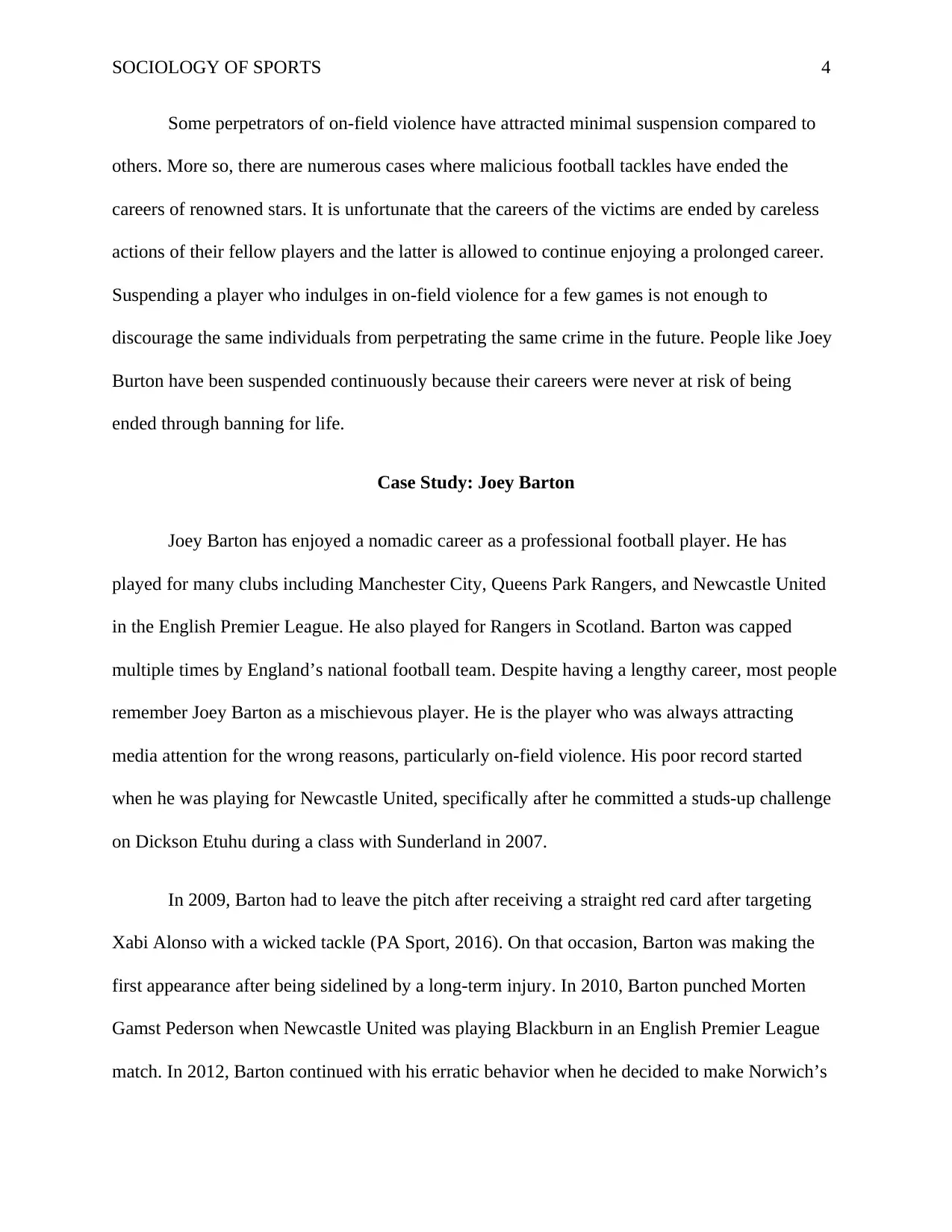
SOCIOLOGY OF SPORTS 4
Some perpetrators of on-field violence have attracted minimal suspension compared to
others. More so, there are numerous cases where malicious football tackles have ended the
careers of renowned stars. It is unfortunate that the careers of the victims are ended by careless
actions of their fellow players and the latter is allowed to continue enjoying a prolonged career.
Suspending a player who indulges in on-field violence for a few games is not enough to
discourage the same individuals from perpetrating the same crime in the future. People like Joey
Burton have been suspended continuously because their careers were never at risk of being
ended through banning for life.
Case Study: Joey Barton
Joey Barton has enjoyed a nomadic career as a professional football player. He has
played for many clubs including Manchester City, Queens Park Rangers, and Newcastle United
in the English Premier League. He also played for Rangers in Scotland. Barton was capped
multiple times by England’s national football team. Despite having a lengthy career, most people
remember Joey Barton as a mischievous player. He is the player who was always attracting
media attention for the wrong reasons, particularly on-field violence. His poor record started
when he was playing for Newcastle United, specifically after he committed a studs-up challenge
on Dickson Etuhu during a class with Sunderland in 2007.
In 2009, Barton had to leave the pitch after receiving a straight red card after targeting
Xabi Alonso with a wicked tackle (PA Sport, 2016). On that occasion, Barton was making the
first appearance after being sidelined by a long-term injury. In 2010, Barton punched Morten
Gamst Pederson when Newcastle United was playing Blackburn in an English Premier League
match. In 2012, Barton continued with his erratic behavior when he decided to make Norwich’s
Some perpetrators of on-field violence have attracted minimal suspension compared to
others. More so, there are numerous cases where malicious football tackles have ended the
careers of renowned stars. It is unfortunate that the careers of the victims are ended by careless
actions of their fellow players and the latter is allowed to continue enjoying a prolonged career.
Suspending a player who indulges in on-field violence for a few games is not enough to
discourage the same individuals from perpetrating the same crime in the future. People like Joey
Burton have been suspended continuously because their careers were never at risk of being
ended through banning for life.
Case Study: Joey Barton
Joey Barton has enjoyed a nomadic career as a professional football player. He has
played for many clubs including Manchester City, Queens Park Rangers, and Newcastle United
in the English Premier League. He also played for Rangers in Scotland. Barton was capped
multiple times by England’s national football team. Despite having a lengthy career, most people
remember Joey Barton as a mischievous player. He is the player who was always attracting
media attention for the wrong reasons, particularly on-field violence. His poor record started
when he was playing for Newcastle United, specifically after he committed a studs-up challenge
on Dickson Etuhu during a class with Sunderland in 2007.
In 2009, Barton had to leave the pitch after receiving a straight red card after targeting
Xabi Alonso with a wicked tackle (PA Sport, 2016). On that occasion, Barton was making the
first appearance after being sidelined by a long-term injury. In 2010, Barton punched Morten
Gamst Pederson when Newcastle United was playing Blackburn in an English Premier League
match. In 2012, Barton continued with his erratic behavior when he decided to make Norwich’s
Secure Best Marks with AI Grader
Need help grading? Try our AI Grader for instant feedback on your assignments.
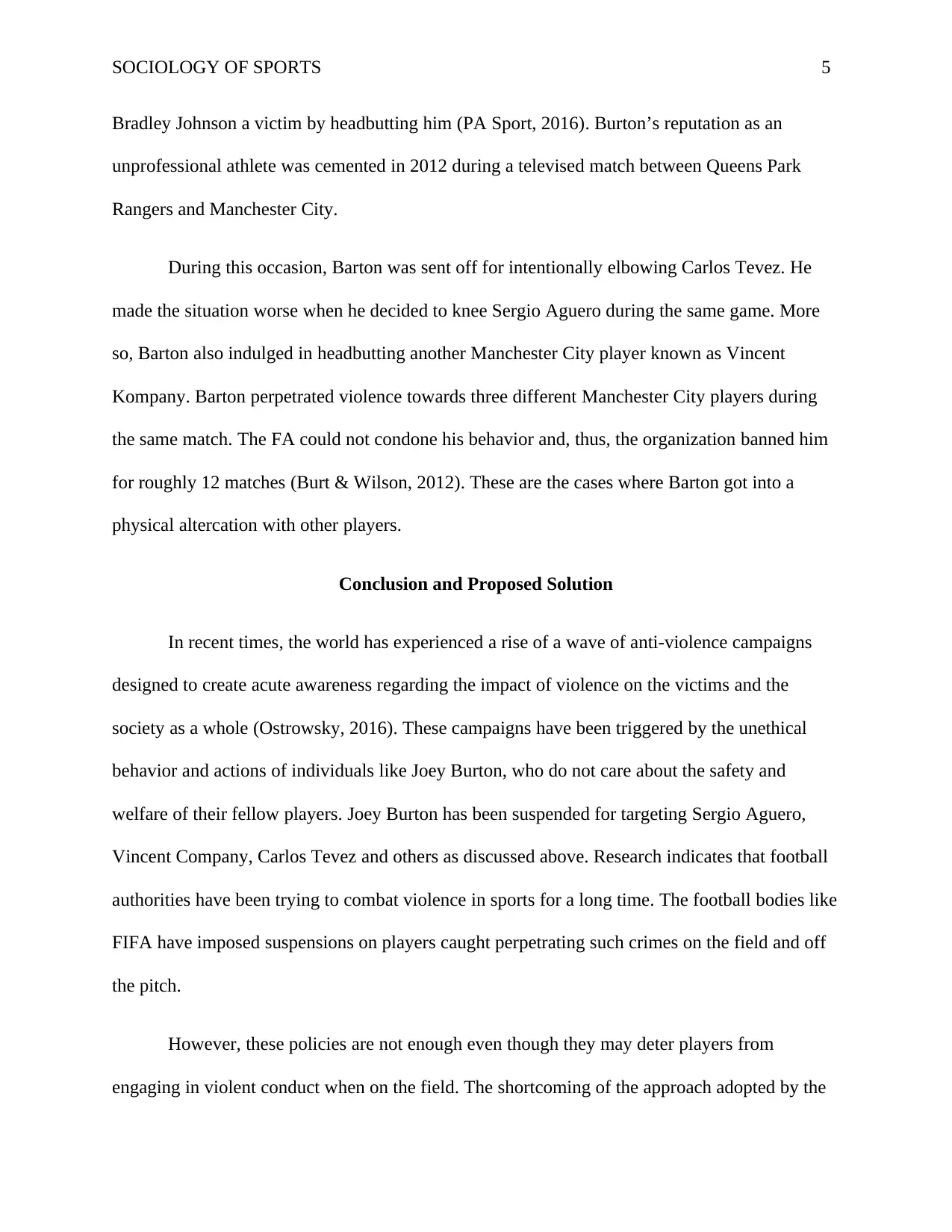
SOCIOLOGY OF SPORTS 5
Bradley Johnson a victim by headbutting him (PA Sport, 2016). Burton’s reputation as an
unprofessional athlete was cemented in 2012 during a televised match between Queens Park
Rangers and Manchester City.
During this occasion, Barton was sent off for intentionally elbowing Carlos Tevez. He
made the situation worse when he decided to knee Sergio Aguero during the same game. More
so, Barton also indulged in headbutting another Manchester City player known as Vincent
Kompany. Barton perpetrated violence towards three different Manchester City players during
the same match. The FA could not condone his behavior and, thus, the organization banned him
for roughly 12 matches (Burt & Wilson, 2012). These are the cases where Barton got into a
physical altercation with other players.
Conclusion and Proposed Solution
In recent times, the world has experienced a rise of a wave of anti-violence campaigns
designed to create acute awareness regarding the impact of violence on the victims and the
society as a whole (Ostrowsky, 2016). These campaigns have been triggered by the unethical
behavior and actions of individuals like Joey Burton, who do not care about the safety and
welfare of their fellow players. Joey Burton has been suspended for targeting Sergio Aguero,
Vincent Company, Carlos Tevez and others as discussed above. Research indicates that football
authorities have been trying to combat violence in sports for a long time. The football bodies like
FIFA have imposed suspensions on players caught perpetrating such crimes on the field and off
the pitch.
However, these policies are not enough even though they may deter players from
engaging in violent conduct when on the field. The shortcoming of the approach adopted by the
Bradley Johnson a victim by headbutting him (PA Sport, 2016). Burton’s reputation as an
unprofessional athlete was cemented in 2012 during a televised match between Queens Park
Rangers and Manchester City.
During this occasion, Barton was sent off for intentionally elbowing Carlos Tevez. He
made the situation worse when he decided to knee Sergio Aguero during the same game. More
so, Barton also indulged in headbutting another Manchester City player known as Vincent
Kompany. Barton perpetrated violence towards three different Manchester City players during
the same match. The FA could not condone his behavior and, thus, the organization banned him
for roughly 12 matches (Burt & Wilson, 2012). These are the cases where Barton got into a
physical altercation with other players.
Conclusion and Proposed Solution
In recent times, the world has experienced a rise of a wave of anti-violence campaigns
designed to create acute awareness regarding the impact of violence on the victims and the
society as a whole (Ostrowsky, 2016). These campaigns have been triggered by the unethical
behavior and actions of individuals like Joey Burton, who do not care about the safety and
welfare of their fellow players. Joey Burton has been suspended for targeting Sergio Aguero,
Vincent Company, Carlos Tevez and others as discussed above. Research indicates that football
authorities have been trying to combat violence in sports for a long time. The football bodies like
FIFA have imposed suspensions on players caught perpetrating such crimes on the field and off
the pitch.
However, these policies are not enough even though they may deter players from
engaging in violent conduct when on the field. The shortcoming of the approach adopted by the
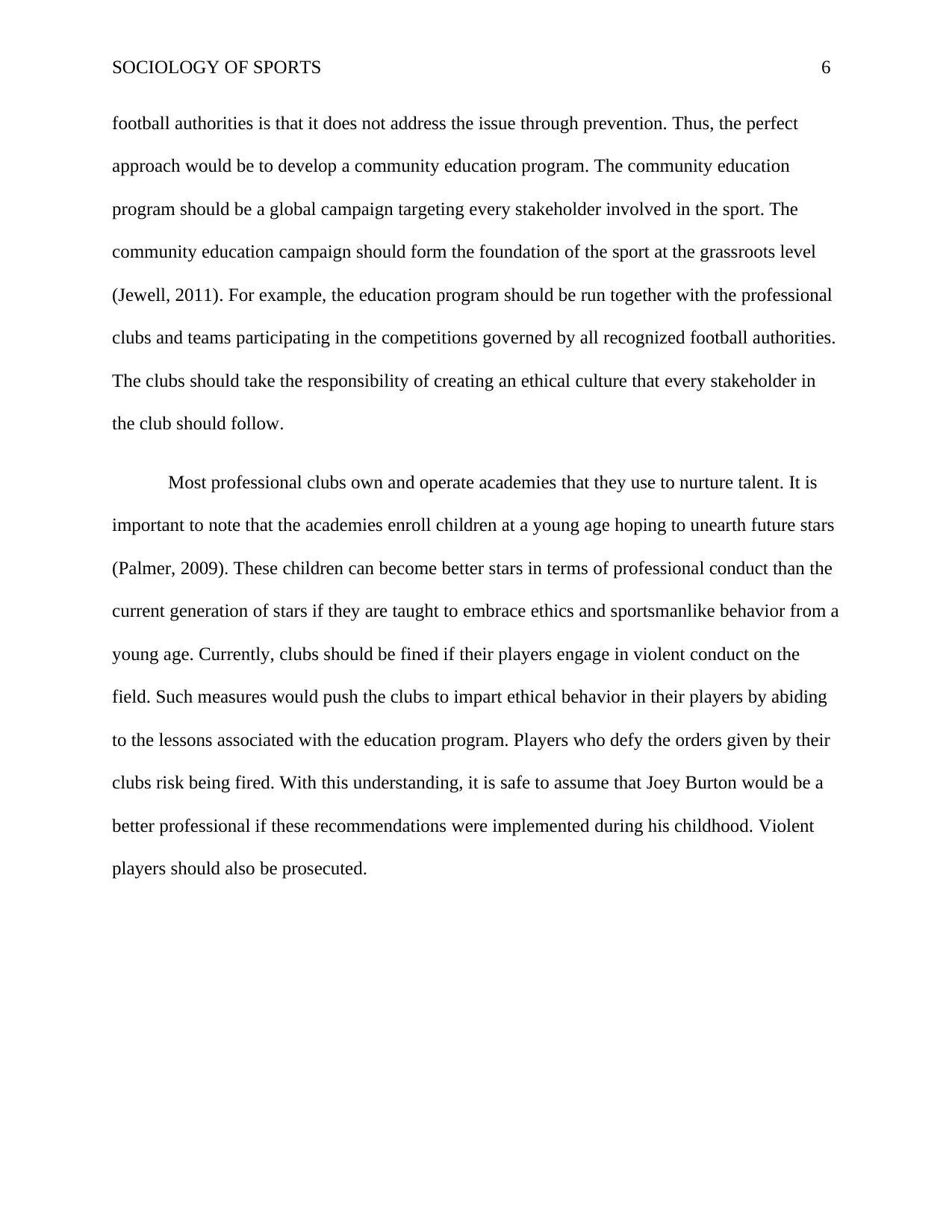
SOCIOLOGY OF SPORTS 6
football authorities is that it does not address the issue through prevention. Thus, the perfect
approach would be to develop a community education program. The community education
program should be a global campaign targeting every stakeholder involved in the sport. The
community education campaign should form the foundation of the sport at the grassroots level
(Jewell, 2011). For example, the education program should be run together with the professional
clubs and teams participating in the competitions governed by all recognized football authorities.
The clubs should take the responsibility of creating an ethical culture that every stakeholder in
the club should follow.
Most professional clubs own and operate academies that they use to nurture talent. It is
important to note that the academies enroll children at a young age hoping to unearth future stars
(Palmer, 2009). These children can become better stars in terms of professional conduct than the
current generation of stars if they are taught to embrace ethics and sportsmanlike behavior from a
young age. Currently, clubs should be fined if their players engage in violent conduct on the
field. Such measures would push the clubs to impart ethical behavior in their players by abiding
to the lessons associated with the education program. Players who defy the orders given by their
clubs risk being fired. With this understanding, it is safe to assume that Joey Burton would be a
better professional if these recommendations were implemented during his childhood. Violent
players should also be prosecuted.
football authorities is that it does not address the issue through prevention. Thus, the perfect
approach would be to develop a community education program. The community education
program should be a global campaign targeting every stakeholder involved in the sport. The
community education campaign should form the foundation of the sport at the grassroots level
(Jewell, 2011). For example, the education program should be run together with the professional
clubs and teams participating in the competitions governed by all recognized football authorities.
The clubs should take the responsibility of creating an ethical culture that every stakeholder in
the club should follow.
Most professional clubs own and operate academies that they use to nurture talent. It is
important to note that the academies enroll children at a young age hoping to unearth future stars
(Palmer, 2009). These children can become better stars in terms of professional conduct than the
current generation of stars if they are taught to embrace ethics and sportsmanlike behavior from a
young age. Currently, clubs should be fined if their players engage in violent conduct on the
field. Such measures would push the clubs to impart ethical behavior in their players by abiding
to the lessons associated with the education program. Players who defy the orders given by their
clubs risk being fired. With this understanding, it is safe to assume that Joey Burton would be a
better professional if these recommendations were implemented during his childhood. Violent
players should also be prosecuted.
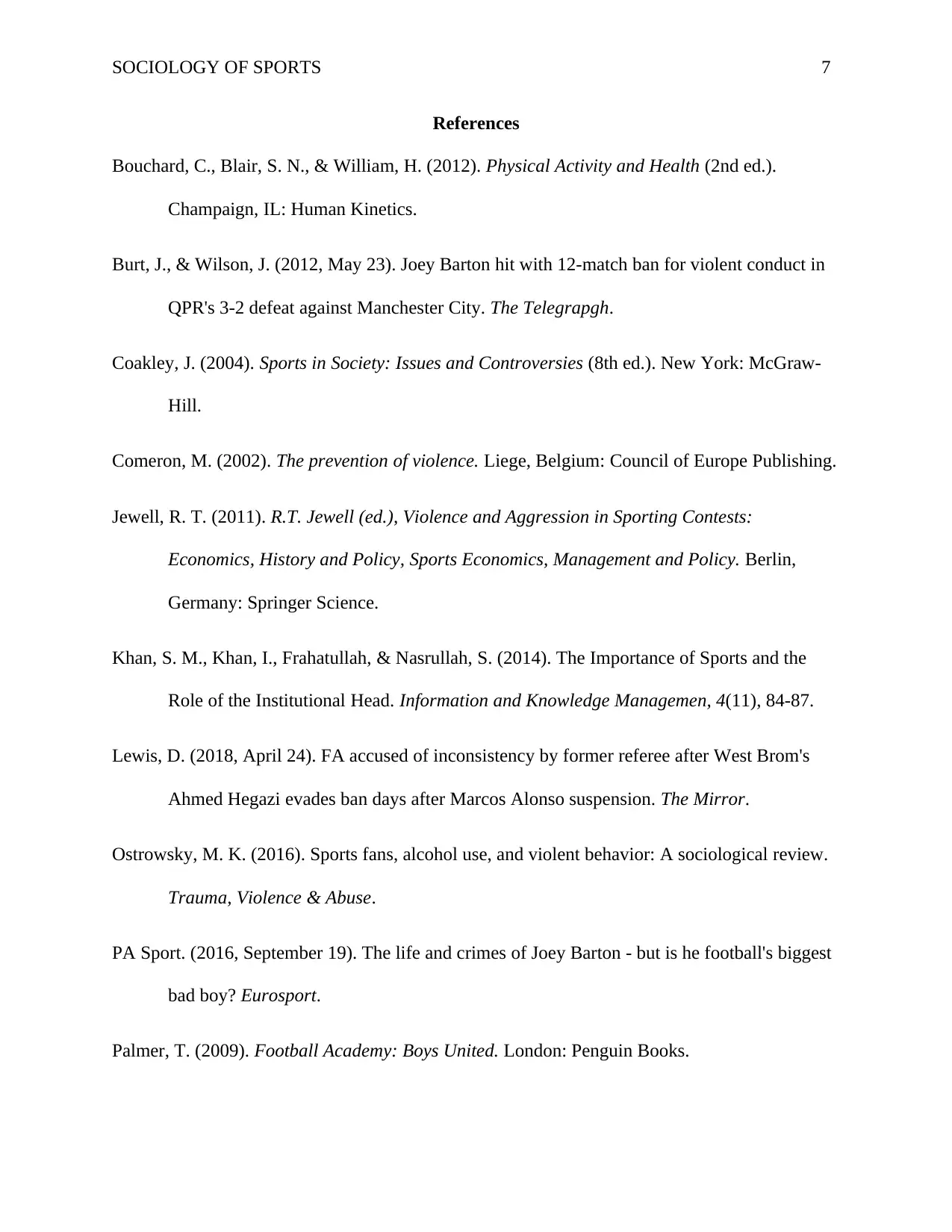
SOCIOLOGY OF SPORTS 7
References
Bouchard, C., Blair, S. N., & William, H. (2012). Physical Activity and Health (2nd ed.).
Champaign, IL: Human Kinetics.
Burt, J., & Wilson, J. (2012, May 23). Joey Barton hit with 12-match ban for violent conduct in
QPR's 3-2 defeat against Manchester City. The Telegrapgh.
Coakley, J. (2004). Sports in Society: Issues and Controversies (8th ed.). New York: McGraw-
Hill.
Comeron, M. (2002). The prevention of violence. Liege, Belgium: Council of Europe Publishing.
Jewell, R. T. (2011). R.T. Jewell (ed.), Violence and Aggression in Sporting Contests:
Economics, History and Policy, Sports Economics, Management and Policy. Berlin,
Germany: Springer Science.
Khan, S. M., Khan, I., Frahatullah, & Nasrullah, S. (2014). The Importance of Sports and the
Role of the Institutional Head. Information and Knowledge Managemen, 4(11), 84-87.
Lewis, D. (2018, April 24). FA accused of inconsistency by former referee after West Brom's
Ahmed Hegazi evades ban days after Marcos Alonso suspension. The Mirror.
Ostrowsky, M. K. (2016). Sports fans, alcohol use, and violent behavior: A sociological review.
Trauma, Violence & Abuse.
PA Sport. (2016, September 19). The life and crimes of Joey Barton - but is he football's biggest
bad boy? Eurosport.
Palmer, T. (2009). Football Academy: Boys United. London: Penguin Books.
References
Bouchard, C., Blair, S. N., & William, H. (2012). Physical Activity and Health (2nd ed.).
Champaign, IL: Human Kinetics.
Burt, J., & Wilson, J. (2012, May 23). Joey Barton hit with 12-match ban for violent conduct in
QPR's 3-2 defeat against Manchester City. The Telegrapgh.
Coakley, J. (2004). Sports in Society: Issues and Controversies (8th ed.). New York: McGraw-
Hill.
Comeron, M. (2002). The prevention of violence. Liege, Belgium: Council of Europe Publishing.
Jewell, R. T. (2011). R.T. Jewell (ed.), Violence and Aggression in Sporting Contests:
Economics, History and Policy, Sports Economics, Management and Policy. Berlin,
Germany: Springer Science.
Khan, S. M., Khan, I., Frahatullah, & Nasrullah, S. (2014). The Importance of Sports and the
Role of the Institutional Head. Information and Knowledge Managemen, 4(11), 84-87.
Lewis, D. (2018, April 24). FA accused of inconsistency by former referee after West Brom's
Ahmed Hegazi evades ban days after Marcos Alonso suspension. The Mirror.
Ostrowsky, M. K. (2016). Sports fans, alcohol use, and violent behavior: A sociological review.
Trauma, Violence & Abuse.
PA Sport. (2016, September 19). The life and crimes of Joey Barton - but is he football's biggest
bad boy? Eurosport.
Palmer, T. (2009). Football Academy: Boys United. London: Penguin Books.
Paraphrase This Document
Need a fresh take? Get an instant paraphrase of this document with our AI Paraphraser
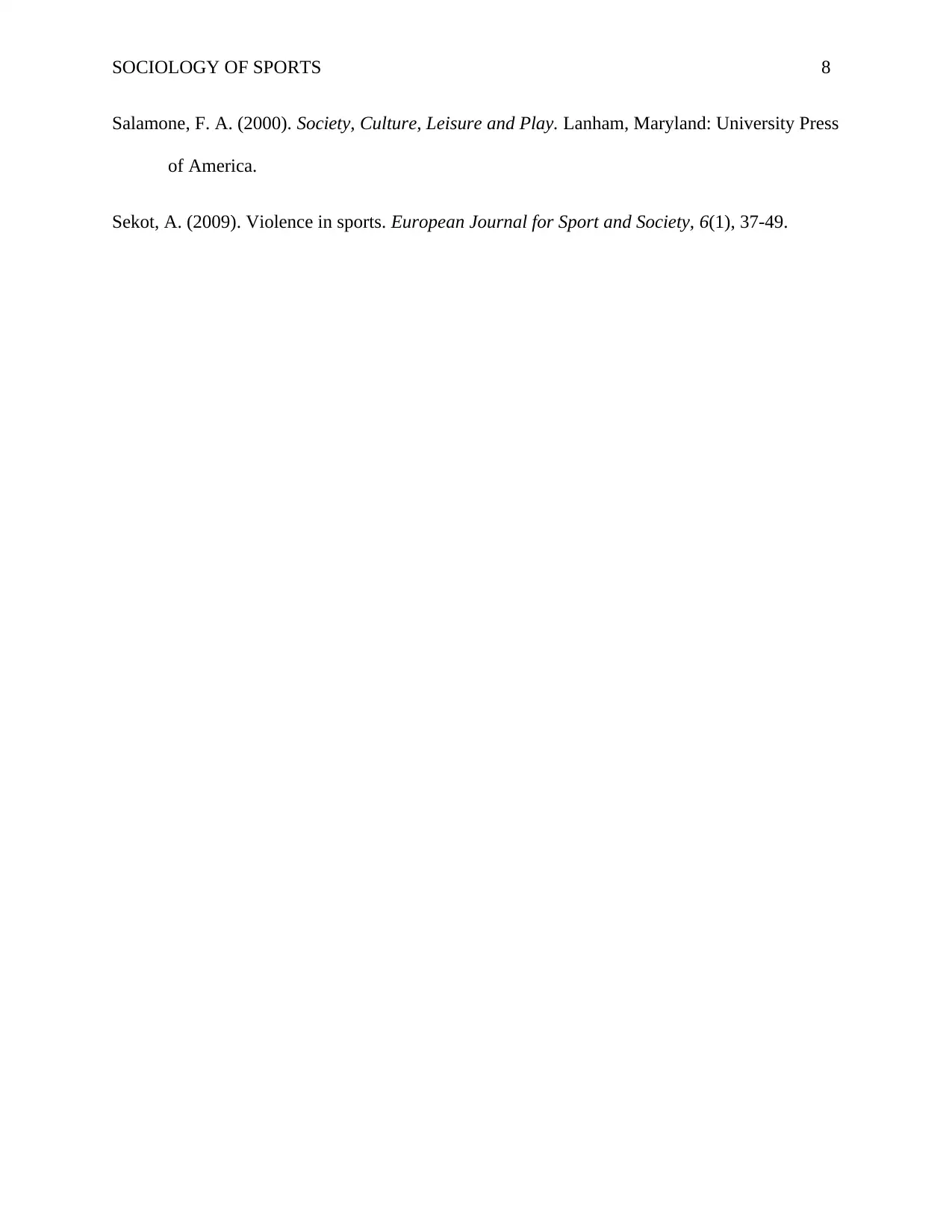
SOCIOLOGY OF SPORTS 8
Salamone, F. A. (2000). Society, Culture, Leisure and Play. Lanham, Maryland: University Press
of America.
Sekot, A. (2009). Violence in sports. European Journal for Sport and Society, 6(1), 37-49.
Salamone, F. A. (2000). Society, Culture, Leisure and Play. Lanham, Maryland: University Press
of America.
Sekot, A. (2009). Violence in sports. European Journal for Sport and Society, 6(1), 37-49.
1 out of 8
Your All-in-One AI-Powered Toolkit for Academic Success.
+13062052269
info@desklib.com
Available 24*7 on WhatsApp / Email
![[object Object]](/_next/static/media/star-bottom.7253800d.svg)
Unlock your academic potential
© 2024 | Zucol Services PVT LTD | All rights reserved.